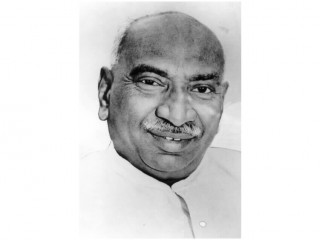
Kumaraswami Kamaraj biography
Date of birth : 1903-07-15
Date of death : 1975-10-02
Birthplace : Virudunagar, India.
Nationality : Indian
Category : Politics
Last modified : 2011-10-12
Credited as : Politician, Congress Committee, Dravida Munnetra Kazagham
Political leader Kumaraswami Kamaraj (1903-1975) rose from the next-to-lowest rung in the caste system of India to become president of the all-powerful Congress party.
He was known simply as Kamaraj, now used as his surname. The low caste Nadars were rising in importance when Kamaraj was born on July 15, 1903, in the southern Madras town of Virudunagar, India. His father, who died when Kamaraj was six, was a coconut merchant. The boy had only six years of schooling when he dropped out to work in his uncle's cloth shop.
At 17 Kamaraj joined the nationalist movement and soon became the chief lieutenant of Madras Congress leader Sundaresa Satyamurti. His steps up the political ladder include: national Congress Committee in 1931, secretary of the state party in 1935, and member of the Madras Legislative Assembly in 1937 and 1946 and of the Constituent Assembly in 1947. In addition, he was state party president from 1939 to 1954, when he replaced the urbane national leader C. Rajagopalachari, a top-caste Brahmin, as chief minister of Madras.
In 1963 Kamaraj began to devote full time to strengthening the state party. He feared the rise of the Dravida Munnetra Kazagham (DMK), a regional group that threatened to lead Madras out of the national union. His resignation to Jawaharlal Nehru stimulated what came to be known as the Kamaraj Plan, which called for officials to resign to devote time to reorganizing the Congress party at the grass-roots level. Kamaraj was made president of the party and his act was interpreted in the selfless sacrifice tradition of Mahatma Gandhi.
When Nehru died in 1964, Kamaraj engineered the selection of Lal Bahadur Shastri as prime minister. The state-level Congress leaders crucial to the transition were dubbed the "syndicate." A second term as Congress president followed.
After Shastri's death in 1966, Kamaraj arranged the selection of Indira Gandhi as prime minister.
Kamaraj's political influence began to descend in 1967 when he was defeated for a seat in Parliament, and the DMK, now respectable, captured control of the Madras government. An increasingly independent Indira Gandhi continued as prime minister, and a conflict ensued between the government and Kamaraj's group. The party formally split in 1969 with Kamaraj as part of the old guard that tried, unsuccessfully, to remove Gandhi from power. In the same year Kamaraj was elected to Parliament in a by-election and began to rebuild his Madras base.
Although Kamaraj was fluent only in the Tamil language, with English or Hindi being the power tongues of India, his political skills and the timing of crucial events combined to make him a respected national leader. His own low-caste birth helped him to bring others of comparable social order into the Congress fold. Kamaraj devoted himself to the affairs of his home state of Madras until his death there on Oct. 2, 1975.
Kamaraj: A Study (1967) by V. K. Narasimhan. Robert L.Hardgrave, Jr.'s The Nadars of Tamilnad (1969) is an excellent study of the rise of Kamaraj's caste. □
















